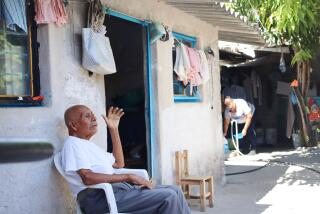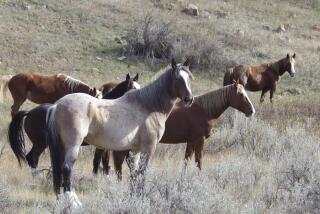Lebanon election has designs on voters
A beautiful woman glances seductively over her shoulder from a billboard on a busy Beirut thoroughfare. But it isn’t perfume or shampoo she’s selling: It’s politics.
The ad, which urges women to “be beautiful and vote,” was one of the more controversial campaign advertisements rolled out by parliamentary candidate Gen. Michel Aoun, whose party is allied with the Islamist group Hezbollah and is expected to make gains in national elections Sunday.
Critics call the ad sexist and pandering, a cheap grab for attention. But with only days until the balloting, there’s not a wall, billboard or street that isn’t plastered with campaign ads, and notoriety is just more free publicity.
“Our strategy was based on one platform, which was that we have to win the elections in 2009,” said Sami Saab, the chief hand behind the ads. “At the end of the day, we made an ad campaign and we are talking to people.”
If Saab sounds like the creative director at a competitive commercial ad agency, it’s because he is. In fact, he took two months’ leave to work full time on the campaign.
The influence of consumer advertising on political campaigns over the years has affected not only the imagery but the rhetoric, said Zeina Maasri, a professor at the American University of Beirut who wrote the book “Off the Wall: Political Posters of the Lebanese Civil War.”
Whereas the small, street-level posters of the 1970s and ‘80s often incorporated intricate art and calligraphy, she said, the huge billboards of today tend to rely on bright colors and simple, brief texts to convey their messages.
“The scale has affected the kind of rhetoric used, and this is true of all the parties,” Maasri said. “The way politics are advertised now is not that much different from the way commodities are advertised.”
Maasri pointed to one of the slogans of March 14, the coalition backed by the United States, as an example of pithy commercial advertising: “I think, there14 I am.”
“The play on words, the Western philosophical stance and the brevity of the message itself” are clearly the products of a modern advertising culture, she said.
In fact, Jean-Pierre Katrib, a political analyst at Quantum Communications, the firm that consulted on the March 14 ads, boasted that his company was “one of the pioneers in introducing satire and pun” to the electoral campaign.
March 14 doesn’t only play with words: The coalition’s symbol, a fist clutching an olive branch, seems suspiciously reminiscent of Hezbollah’s signature fist holding a Kalashnikov rifle.
“It could be seen as such; we don’t like to limit it to one definition,” Katrib said. “We would be very glad to see a debate being launched on this track as to what this hand represents.”
Hezbollah too has an ad campaign that many describe as effective, including yellow billboards with the words “Our Lebanon, Your Lebanon, My Lebanon” crossed out above just the word “Lebanon.”
The group’s iconic logo appears in the background, faint and faded, reassuring swing voters that its militant ways will soon dissipate as the nation becomes stronger.
Although nobody knows exactly how much each party is spending on advertising, the huge billboards and banners as tall as buildings are clearly a significant investment.
“We are talking about major official expenditures,” Maasri said.
“Then again,” she added, “before, the money would probably have gone to weapons, so maybe it’s a good sign that it’s being spent on campaigning.”
--
Lutz is a special correspondent. Times staff writer Borzou Daragahi contributed to this report.
More to Read
Start your day right
Sign up for Essential California for news, features and recommendations from the L.A. Times and beyond in your inbox six days a week.
You may occasionally receive promotional content from the Los Angeles Times.






